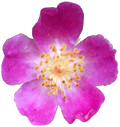Russian Knapweed
(Centaurea repens) Aster Family / Thistle Subfamily
By Thomas J. Elpel with additions by Pamela G. Sherman

About Russian Knapweed: Although Russian knapweed is closely related to the spotted and diffuse knapweeds, there are some distinct differences too, enough differences that it is sometimes considered a different genus, Acroptilon repens. This knapweed has pink to lavender flowers with white papery bracts. Instead of emphasizing mass seed production like the other knapweeds, Russian knapweed puts much of its energy into a deep , vigorous, creeping, scaley, black root system. New plants shoot up from the roots and crown buds, forming dense patches of cloned plants. Thus the plant is slower to establish, but more difficult to eradicate than the other knapweeds. The plants are long-lived perennials, known to live more than 75 years. It favors poorly drained and alkaline/saline soils, but does not do well in dense shade or severe drought. Russian knapweed infests about 47,000 acres of rangeland in Montana.
An ethnopharmacological study in Baluchistan, Pakistan, found that of all the medicinal plants studied, Russian knapweed had "the highest use value." [www.ncbi.nlm.nih.gov]
Russian knapweed contains sesquiterpene lactones, which can cause irreversible brain damage in horses, a disorder called "chewing disease" (equine nigropallidal encephalomalacia). Affected horses are unable to chew or use their lips normally; It is also characterized by yawning, standing with the head down, aimless walking, head pressing, and difficulty breathing. They may be aggressive at first. The disease has occurred in horses that consumed more than 60% of their body weight of the weed within 1-2 months. There is no known cure, and death results from starvation or dehydration. The plants are toxic wet or dried. Horses only graze on Russian knapweed if no other forage is available, or if it is included in hay.
Mechanical Controls: Cultivation has little effect on Russian knapweed, unless combined with herbicides. Cultivation is likely to spread the plants by dicing and redistributing the roots.
Biological Controls: A gall-forming nematode (Subanguina picridis) has been released in this country to control Russian knapweed. It forms galls on the stems, leaves, and root crown of the plants. Other studies are being conducted with a gall forming wasp (Aulacida acroptilonica) and a rust fungus (Puccinia acroptili).
According to University of Colorado Professor Tim Seastedt, who has been studying Knapweed control for twenty years, "knapweeds...can be successfully controlled with bio- controls . Knapweeds can also be controlled mechanically, given the human will to keep at it. " [Seastedt]
Grazing: Sheep and goats probably eat Russian knapweed without ill effects, but I have yet to find confirmation of that.
Seeding: Irrigated crops like alfalfa can produce enough shade to limit, but not eliminate the weed. Seeding perennial grasses in late fall, as well as forbs and shrubs, is necessary to prevent re-invasion. [Larimer County, CO Weed District]
Chemical Controls: Other than 2,4-D, the same herbicides used for spotted or diffuse knapweeds can be used for Russian knapweed, but at a more concentrated dose. Herbicides are best applied when the weed is in the bud to early bloom stage, or in the fall after a light frost. Since Russian knapweed grows in dense patches it may be easier to target with herbicides than other knapweeds. However the herbicide should be sprayed an additional ten to fifteen feet beyond the patch to get other emerging shoots or seedlings.
Important: Most "weed problems" are really "people problems" from poor land management and a lack of ecological insight. It is easy to reach for a tool like fire, mowing, or herbicides to attack an out-of-control weed, but often those tools do little to get to the root cause of the weed infestation, and sometimes make the problems worse. Please read more about range ecology, desertification, and invasive weeds on this website before applying any tool of weed control. Go to: Desertification and Invasive Weeds.
Notes
- Thomas J. Elpel. Botany in a Day. HOPS Press: Pony, MT. January 2000.
- _____. "Ecology and Distribution of Acroptilon repens". USGS-BRD, Colorado Plateau Field Station. https://www.usgs.nau.edu/swemp/Info_pages/plants/Acroptilon/Russianknapweed.html
- Rodney G. Lym. "Know Your Knapweeds". North Dakota State University NDSU Extension Service. W-1146, March 1998. https://www.ext.nodak.edu/extpubs/plantsci/weeds/w1146w.htm.
- _____. "VALUE AND USE-SPECIES: Centaurea repens". U.S. Forest Service Fire Effects Information System: https://www.fs.fed.us/database/feis/plants/forb/cenrep/.
- https://www.ncbi.nlm.nih.gov/pubmed/25260579.
- Identification and Management of Knapweeds in Colorado. Produced by Larimer County, CO Weed District.
- Personal communication to Pamela Sherman from University of Colorado Professor Tim Seastedt re: knapweed control.
Return to the Weed Profiles Table of Contents





 Wildflowers-and-Weeds.com
Wildflowers-and-Weeds.com 






